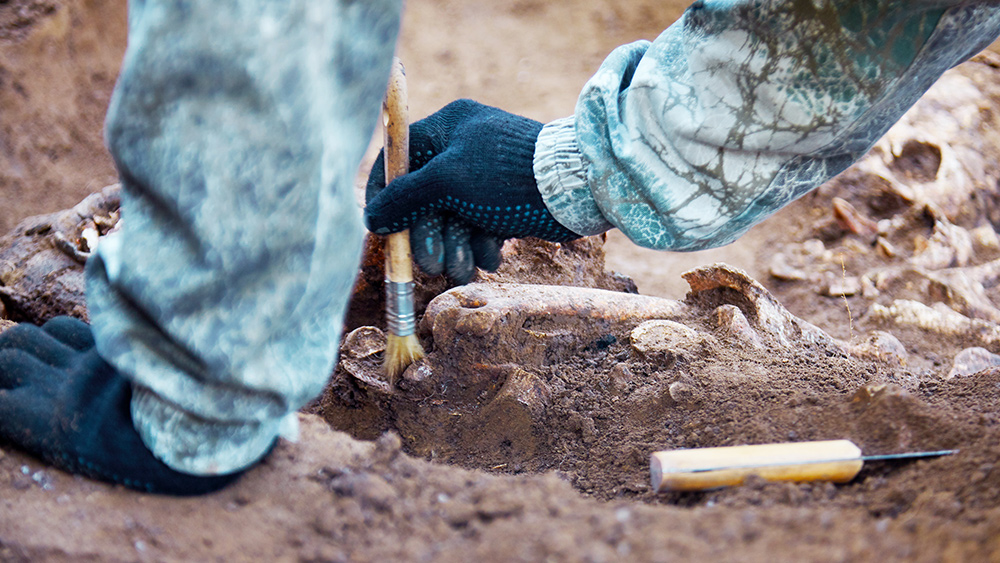10,000 year old “weapons factory” discovered by archeologists alongside remains of a wooly mammoth, whose tusks were used as raw materials
02/23/2020 / By Arsenio Toledo

Paleontologists working on the island of Kotelny, a now-uninhabited Siberian island administered by Russia and located within the Arctic circle, have discovered a “weapons factory” where early humans took shards of mammoth tusks and sharpened them into knives and spears. Not only that, but this “weapons factory” was discovered right beside the remains of a felled woolly mammoth, whose remains were preserved – and then dug up – underneath the permafrost. The paleontologists who made the discovery believe the mammoth remains are at least 10,000 years old.
Specialists from the Academy of Sciences of Yakutia, the Russian province that administers the region, found markings on the mammoth tusks as well as on a rib, which suggested to the paleontologists that the giant animal was hunted down. “Traces of processing, presumably by an ancient man, were found on the tusk fragments,” Innokenty Pavlov, the mammoth expert who found the remains, said in an interview with The Siberian Times. (Related: Scientists dig up perfectly preserved 42,000-year-old horse – with blood and internal organs intact.)
According to Pavlov, the ivory shards they discovered had sharp edges. Pavlov said this could mean that the shards were either turned into spears, making them useful for killing animals, or knives, so that they can butcher what they hunt down. “The state of tusk remnants clearly points [out] that the humans sliced it to make implements (and weapons),” Pavlov said.
Kotelny holds many secrets underneath its permafrost
The remains of the mammoth, which weighed approximately 52.03 lbs (23.6 kg) will be taken back to Yakutia’s capital of Yakutsk where Pavlov and the researchers will further examine the fossil, as well as determine its exact age through radiocarbon dating. The remains of the mammoth, dubbed the “Golden mammoth” due to the striking coloration of its fur, were covered in sand and buried in permafrost. It was only visible to Pavlov and the other paleontologists during low tide.
The researchers believe that the mammoth may be a member of a previously undescribed species of “mini mammoth” that lived during the tail end of the last ice age. The mammoth was measured to be only seven feet tall, less than half the typical height of a woolly mammoth.
During the Pleistocene era, a period of time that began sometime around 2.6 million years ago and lasted until around 11,700 BC, Kotelny and many other islands surrounding it, collectively known as the New Siberian Islands, were connected to the rest of the Eurasian landmass. In fact, this part of Siberia is known by paleontologists all over the world as a necropolis for mammoth remains. In fact, the youngest mammoths ever discovered, dated to around 4,000 years ago, were discovered in an island less than a thousand miles away from the New Siberian Islands.
Other sites around Kotelny also contain evidence of human activity. The site of the Golden mammoth is close to the site of a 50,000-year-old pygmy woolly mammoth that scientists still haven’t been able to excavate.
The expedition was organized and funded with the help of the Russian Geographical Society and the Russian Ministry of Defense, who have a base on the island.
If you’re interested in learning about more new finds by paleontologists, archaeologists and other historians and researchers, head over to Artifacts.news.
Sources include:
Tagged Under: ancient history, animals, Archaeology, artifacts, discoveries, extinct animals, fossils, history, ice age, ice age history, mammoth, paleontology, prehistoric animals, prehistoric people, real history, research, Russia, Siberia, woolly mammoth
RECENT NEWS & ARTICLES
COPYRIGHT © 2017 ARTIFACTS NEWS



















